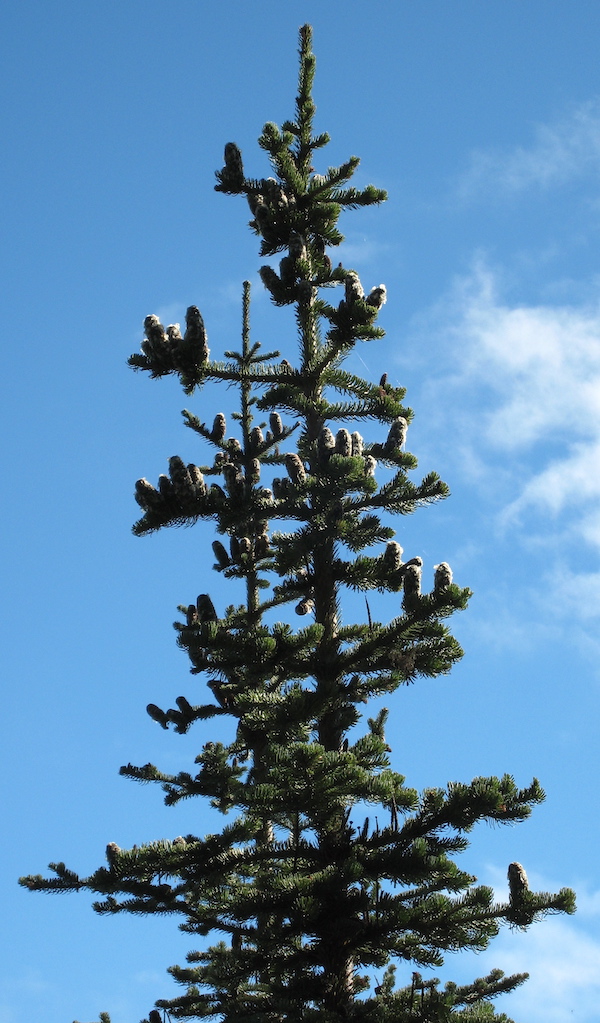| Trees vary in scent juast as they do in other ways. Here is a brief account of the subject. A whole book could be written . . . |
| A person's dectection of scent --as with taste, sight or hearing-- may be not only acute or dull, but moreover some individuals cannot smell at all certain scents that others can detect easily. |
My examples below are biased towards trees with which I am familiar in Seattle. Therefore, numerous tropical trees are excluded even if world-famous for fragrance.
|
| Trees releasing scent if their foliage is bruised or crushed: |
| Bay LAUREL Laurus nobilis |
| ELDER Sambucus spp. |
| Grand FIR Abies grandis |
| HOP TREE Ptelea trifoliata |
| Oregon MYRTLE Umbellularia californica |
| Japanese NUTMEG-TREE Torreya nucifera |
| PAWPAW Asimina triloba |
| PEANUT BUTTER TREE Clerodendrum trichotomum |
| Szechwan PEPPER Zanthoxylum simulans |
| Chinese PISTACHIO Pistacia chinensis |
| SASSAFRAS Sassafras albidum |
| SMOKE TREE Cotinus Coggygria |
| SWEETGUM Liquidambar Styraciflua |
| Chinese TOON Toona (Cedrela) sinensis |
Black WALNUT TREEJuglans nigra
|
| Trees emitting volatile organic compounds, at least when the air is warm and humid enough. You merely stroll by and smell them. Warmth increases both fragrance and flavor, which is why cold cheese is less delectable than warm cheese, and stout beers such as Guinness taste best when not too cold: |
| BOXWOOD Buxus sempervirens |
| Alaska CEDAR Cupressus nootkatensis |
| Alpine FIR Abies lasiocarpa & A. bifolia |
| Blue GUM Eucalyptus globulus and many other spp. |
| JUNIPER Juniperus spp., especially J. occidentalis |
Sierra REDWOOD Sequoiadendron giganteum
|
| Tree flowers, especially anthers, releasing strong fragrance: |
| AZARA Azara microphylla |
| BROOM Genista ætnensis |
| EMPRESS TREE Paulownia tomentosa |
| LINDEN & BASSWOOD Tilia spp. |
| Black LOCUST Robinia Pseudoacacia |
| MAGNOLIA Magnolia spp., especially M. hypoleuca |
| Sweet OLIVE Osmanthus spp. (males) |
| ORANGE & LEMON Citrus spp. & hybrids |
| PRIVET Ligustrum spp. |
| RUSSIAN OLIVE Elæagnus angustifolia |
| TREE OF HEAVEN Ailanthus altissima (males) |
| WILLOW Salix spp. & hybrids (males) |
WITCH HAZEL Hamamelis mollis & hybrids
|
| Trees whose broken twigs or sawed wood emit notable odor: |
| Sweet BIRCH Betula lenta |
| Yellow BIRCH Betula alleghaniensis |
| Black CHERRY Prunus serotina |
| CHINESE SCHOLAR-TREE Sophora/Styphnolobium japonica |
| EMPRESS TREE Paulownia tomentosa |
| Black LOCUST Robinia Pseudoacacia |
SMOKE TREE Cotinus Coggygria
|
| Trees whose fully ripe fruit, especially when rotting, give a fermented, sweetish fragrance:
|
| FIG TREE Ficus Carica |
| MAIDENHAIR TREE Ginkgo biloba |
| PEACH TREE Prunus Persica |
PEAR TREE Pyrus communis
|
| Trees with miscellaneous seasonal fragrance: |
| COTTONWOOD and Black POPLAR Populus spp. at spring budding |
KATSURA Cercidiphyllum japonicum at autumn leaf shedding
|
| Karen MacNeil wrote in The Wine Bible: "The genes that encode for olfaction are the largest group of genes in the body. Of the one million genes in the human genome, thirty thousand are solely dedicated to encoding smells." |
Whole books exist on fragrant plants. The best is Roy Genders' Scented Flora of the World. It includes trees.
Back |

Ginkgo fruit ; photo by ALJ
|

Alpine Fir ; photo by ALJ
|

